海水的盐度与温度作为人类探索并研究海洋的重要基本参数,其测量对海洋研究至关重要。目前,最广泛使用的海洋测量装置是电导率-温度-深度(CTD)仪器, 可以测量海水盐度与温度[1],具有精度高和实用性广的优点。然而,考虑到其设备本身构造复杂、尺寸相对较大,造价高昂,目前急需一种微尺寸、造价低廉的传感器,以满足对海水的盐度和温度同时测量的需求。近几年,利用微光纤传感器测量海水盐度或温度的研究已取得了相对较好的进展,例如使用微光纤环形谐振腔[2-5]、双折射椭圆光纤[6]、马赫曾德光纤干涉仪[7-9]等进行盐度或温度单参数测量的研究,它们都体现了微尺寸,连续性与抗电磁干扰能力强等特点。针对海洋内波、热盐环流等海洋动力现象研究,迫切需要同时测量这两个参数的新方法。
微光纤耦合器作为多输入、输出端口的重要光学器件,具有高信噪比、调节光功率分配、以及易于制作,成本低廉等优势,广泛用于气体检测、磁场传感、生物化学传感等多个领域[10-13]。同时,应用于光宽带单模式操作[14],光纤激光器[15]及陷波滤波器[16]的微光纤耦合器为多端口输出微型设备提供了实验及理论依据。相较于微光纤马赫曾德尔干涉仪[17-18]等基于模式耦合的单根微光纤传感器,微光纤耦合器是由两根微光纤弱熔合而成,能够激发更多能量的倏逝场,且不同模式倏逝场的耦合也对环境的变化更为敏感,这意味着微光纤耦合器拥有更高的灵敏度。通过控制微光纤耦合器均匀腰区直径大小找到光谱弥散转折点,可以得到超高折射率灵敏度,为海水盐度等参数的高灵敏度测量可行性提供了实验验证[19-20]。利用微光纤耦合器作探针的温度传感器[21]和涂覆有硅胶的湿度温度传感器[22]的研究均达到了理想的灵敏度,为海水中盐度和温度的同时测量奠定了良好的基础。
本文研制了一种基于2×2四端口微光纤耦合器,实现了海水盐度和温度的同时测量。传感器测量结果的相对误差分别为3.39%和3.97%,表明此传感器具有很好的准确性。该传感器具有小尺寸、易于制作、灵敏度高等优势,为未来低成本化、多功能化、集成化的光纤传感手段研究海洋环境与海洋动力现象提供了新方法。
1 原理一种用于海水盐度和温度同时测量的新型微光纤传感装置,其结构如图 1所示。微光纤耦合器由2个输入端口(Port 1和Port 2),2个输出端口(Port 3和Port 4)和耦合区组成。其中,耦合区是由2根平行的单模光纤经火焰拉伸技术而得的2个锥形过渡区与均匀腰区组成,中间的均匀腰区通过两端的锥形过渡区与输入端口、输出端口相连接。
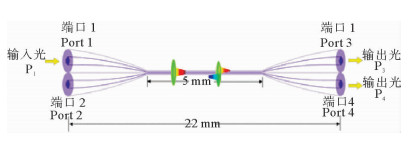
|
图 1 微光纤耦合器示意图 Fig. 1 Schematic diagram of microfiber coupler |
耦合器中,2根微光纤的耦合区形成了新的波导。根据超模耦合理论[23],当光从端口1进入耦合器的锥形过渡区时,偶超模与奇超模将被同时被激发。在均匀腰区,以上2种超模沿着波导传输并逐渐累积相位差,最终耦合到输出端的锥形过渡区,发生模式干涉。于是,在不同的光程上,将出现不同的能量分布情况,不同的输出端也将得到不同的干涉条纹。输出端口3与4的输出能量分别为[24]:
| $ {{P_3} = {P_1}{{\cos }^2}\phi },$ | (1) |
| $ {{P_4} = {P_1}{{\sin }^2}\phi 。} $ | (2) |
此时,两超模在耦合区传输过程中所累积的相位差满足下式[19]:
| $ \varphi = \frac{{{\beta _{{\rm{even }}}} - {\beta _{{\rm{odd }}}}}}{2}L = \frac{{{\rm{ \mathit{ π} }}\left( {n_{{\rm{eff }}}^{{\rm{een }}} - n_{{\rm{eff }}}^{{\rm{odd }}}} \right)}}{\lambda }L。$ | (3) |
式中:βeven, βodd, neffeven, neffodd分别为偶超模、奇超模的传播常数与有效折射率;L为奇超模与偶超模在第一个锥形过渡区被同时激发出的位置至第二个锥形过渡区被耦合回光纤位置之间的距离;λ为模式波长。
通过(3)式可以看出,输出端最终的能量分布取决于耦合区的长度与超模的有效折射率。由于均匀腰区的直径为微米甚至纳米级,光场在此区域传播时大部分能量会以倏逝场的形式在均匀腰区以外的空间传播,而且,耦合器中传播模式的有效折射率与外界环境的折射率越接近,就会有更多能量的倏逝场,它对周围环境折射率的变化非常敏感。即周围环境变化(例如海水的盐度或温度)所引起其自身折射率的变化对超模的有效折射率影响显著。本文利用以上性质,在保持耦合器其他参数不变的情况下,测量海水的盐度和温度变化。
2 实验系统与传感器制作利用研制的关键传感器与超连续光源(Super K Compact)、光谱仪(Yokogawa AQ6370C)所搭建的实验系统如图 2所示。两侧对称位置各有矩形开口的样品池(直径为6.00 cm)位于温控加热平台(JR-200)上,位于样品池溶液内的传感器由两侧光纤夹支撑以悬浮于溶液中。来自超连续光源的宽带光从端口1进入耦合器,再从端口3与端口4输出,其中,端口3直接与光谱仪相连接。所以,在实验中主要以观察端口3的输出光谱进行研究。
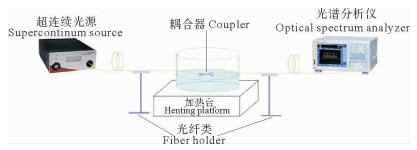
|
图 2 实验系统示意图 Fig. 2 Schematic diagram of the experimental system |
采用火焰拉伸法进行四端口微光纤耦合器的制作(见图 3)。将2根单模光纤中部剥除涂覆层,得到长度约为35.00 mm的裸光纤,并将裸光纤轴向平行对齐。为了增加拉锥时光纤的机械强度与耦合程度,将两光纤一端共同固定在三维调节平台上,使两光纤相互缠绕形成相互交织的整体,并将另一端也固定在三维平移平台上。最后,调整好火焰与光纤的垂直距离,待光纤软化,通过控制两个三维调节平台,向两侧匀速拉伸光纤,得到2×2四端口耦合器。
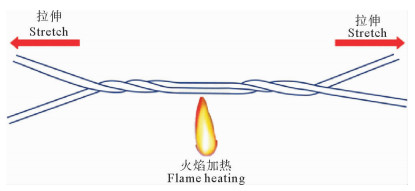
|
图 3 火焰拉伸法制作微光纤耦合器原理图 Fig. 3 Schematic diagram of microfiber coupler by flame taper method |
研制的微光纤耦合器光学显微镜图像如图 4所示,整个耦合器长度约为22.00 mm,均匀腰区长度约为5.00 mm,其最细部分直径约为1.70 μm,即单根微光纤直径为0.85 μm。

|
(插图:均匀腰区10×50倍光学显微镜图像。Inset: 10×50 fold optical microscope image of the finest part of uniform waist region. Inset: 10×50 fold optical microscope image of the finest part of uniform waist region. ) 图 4 微光纤耦合器10×20倍光学显微镜图像 Fig. 4 10 ×20 fold optical microscope image of microfiber coupler |
在入水测试之前,首先在室内空气中记录下输出端口3、4的输出光谱,如图 5所示。表明实验结果与公式(1)、(2)相一致,输出端口3、4的输出光谱分别为余弦函数平方和正弦函数平方,两微光纤耦合成功,完成了微光纤耦合器的制作。
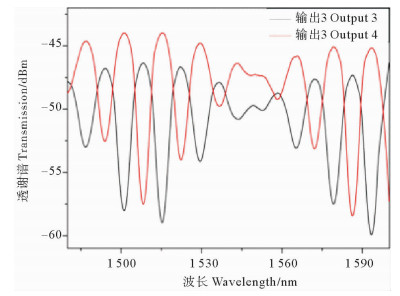
|
图 5 空气中微光纤耦合器输出端口3、4的透射光谱 Fig. 5 Transmission spectra of the output port 3 and 4 of microfiber coupler in the air |
为了测量海水盐度的变化,在温度一定的情况下,向样品池内的海水中缓慢滴入适量蒸馏水, 以改变海水盐度。其中,样品池内的海水是取自青岛近岸的海水样品(初始盐度为35.00),并由盐度计(Atago, PR-100SA)测出待测样品的盐度。使盐度从35.00减少至24.00,不同盐度海水中耦合器的输出光谱如图 6所示。为了探究传感器对海水盐度的灵敏度,观测波谷1和波谷2的波长移动(它们分别位于波长1 541.65和1 572.82 nm处),可以看出,两个波谷都随着盐度的减少而向短波长方向移动。图 7、8分别为波谷1和波谷2的波长随盐度变化曲线,其中,波谷1和波谷2的盐度灵敏度分别为1 418.00和1 600.00 pm/‰。
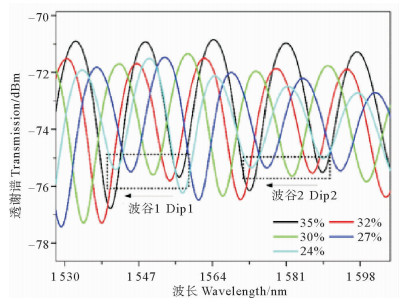
|
图 6 在温度26.00 ℃不同盐度的海水中输出端口3的输出光谱 Fig. 6 Transmission spectra of the output port 3 in seawater with different salinities under temperature of 26.00 ℃ |
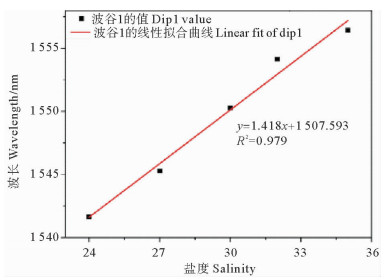
|
图 7 波谷1的波长随盐度的变化曲线 Fig. 7 The relationship between the wavelength and salinities of the dip1 |
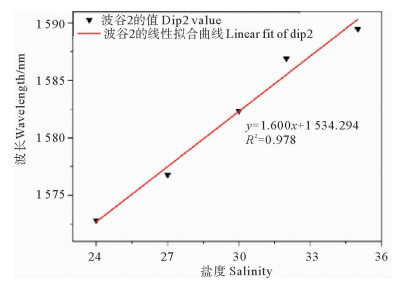
|
图 8 波谷2的波长随盐度的变化曲线 Fig. 8 The relationship between the wavelength and salinities of the dip2 |
完成了海水盐度测量实验后,样品池内的海水盐度为24.00,温度依然为26.00 ℃。为了做到同时测量海水盐度与温度的变化,在测量温度变化的实验中,需把样品池内海水盐度保持在24.00,然后用热电偶温度计(TASI-8620)实时监测样品池内海水温度。开启温控加热平台加热样品池,使样品池内海水温度从26.00 ℃增加至37.70 ℃。不同温度海水中传感器的输出光谱如图 9所示。为了探究传感器对海水温度的灵敏度,仍追踪输出光谱波谷1与波谷2的漂移情况,可以看出,两个波谷都随着温度的增加而向短波长方向移动。图 10、11分别为波谷1和波谷2的波长对应不同温度的线性拟合曲线,得到波谷1和波谷2的温度灵敏度分别为-745.00和-778.00 pm/℃。
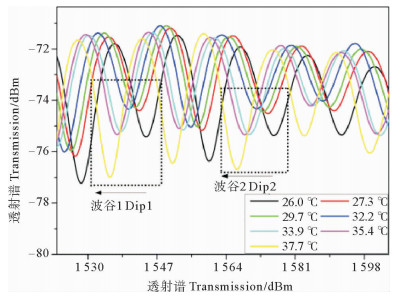
|
图 9 在盐度为24不同温度的海水中输出端口3的输出光谱 Fig. 9 Transmission spectra of the output port 3 in seawater with different temperatures under salinity of 24 |
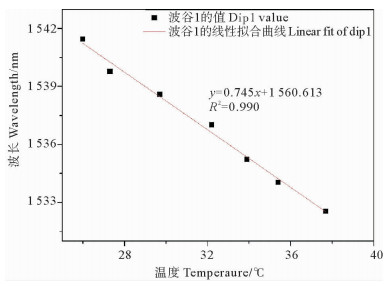
|
图 10 波谷1的波长随温度的变化曲线 Fig. 10 The relationship between the wavelength of temperatures and the dip1 |
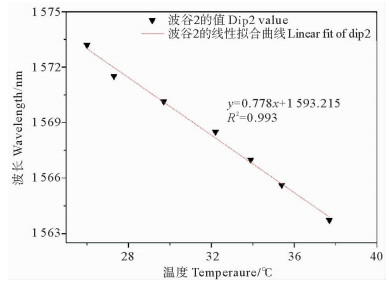
|
图 11 波谷2的波长随温度的变化曲线 Fig. 11 The relationship between the wavelength of temperatures and the dip2 |
通过以上两个实验,得知海水盐度和温度的变化都会导致耦合器输出光谱的漂移,使各个波谷的位置发生改变。当只有盐度或温度改变时,盐度与温度所造成的波谷漂移情况也不相同。当海水盐度与温度同时改变时,它们将共同决定波谷的最终位置。所以,盐度、温度与两个波谷位置的关系可以用灵敏度矩阵表示为:
| $ \begin{array}{l} \left[ \begin{array}{l} {\lambda _1} - 1\;541.65\;{\rm{nm}}\\ {\lambda _2} - 1\;572.82\;{\rm{nm}} \end{array} \right] = \\ \left[ \begin{array}{l} 1\;418\;{\rm{pm/‰ - 745}}\;{\rm{pm/}}^\circ {\rm{C}}\\ 1\;600\;{\rm{pm/‰ - 778}}\;{\rm{pm/}}^\circ {\rm{C}} \end{array} \right]\left[ \begin{array}{l} \;S - 24\\ T - 26\;^\circ {\rm{C}} \end{array} \right] \end{array} $ | (4) |
式中:λ1,λ2分别为波谷1与波谷2漂移后最终的波长;S,T分别为当前海水的盐度与温度。(4)式表明,海水盐度、温度改变值与波谷漂移量的关系可由以灵敏度为系数所建立2×2矩阵决定。所以,只要知道了两波谷波长,就可以直接计算出当前海水的温度与盐度。
为了检验耦合器对于海水温度盐度测量的准确性,在完成测温实验后,待样品池内海水自然冷却,向其加入适量温度为2.30 ℃的蒸馏水来改变海水的温度与盐度,以作为测试样品,其输出光谱如图 12所示。用盐度计与热电偶温度计检测出测试样品的盐度与温度分别为23.00与24.20 ℃,测量并经(4)式计算得出的盐度与温度分别为23.78与23.24 ℃,测量的相对误差分别为3.39 %与3.97 %。可见,本文所设计的微光纤传感器可同时测量海水盐度温度。
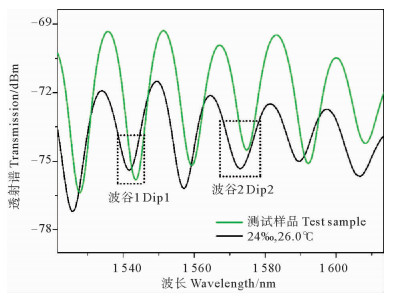
|
图 12 测试样品的输出光谱 Fig. 12 Transmission spectra of sample for testing |
本文所研制的微光纤耦合器最大盐度灵敏度是微光纤环形谐振腔[4, 25]的7~75倍(21~208 pm/‰)、光子晶体光纤[26-27]的119~144倍(11.00~13.00 pm/‰)、双芯光纤[28]的6倍(252.00 pm/‰);其最大温度灵敏度是布拉格光纤光栅[29-30]的39~78倍(10.00~20.00 pm/℃)、马赫曾德尔干涉仪[7, 18]的3~10倍(81.00~239.00 pm/℃)。这表明本文研制的微光纤耦合器有较高的盐度与温度灵敏度,为海洋探测提供一种新型高灵敏度的光学探测方法。
4 结语本文研制了一种可用于海水盐度温度同时测量的2×2四端口微光纤耦合器传感装置。利用耦合器倏逝场对周围介质折射率的高灵敏度,以及偶超模与奇超模在均匀腰区传播时累积的相位差所形成的干涉谱,完成了对海水盐度与温度的同时测量。通过追踪输出光谱在1 541.65和1 572.82 nm波长附近的两个波谷随着盐度与温度的变化,分别得到盐度灵敏度为1 418.00和1 600.00 pm/‰、温度灵敏度为-745.00和-778.00 pm/℃的灵敏度矩阵。利用灵敏度矩阵建立起盐度、温度与两波谷位置的联系,实现了对任意待测海水样品的盐度和温度同时测量。通过传感器与盐度计、热电偶温度计的任意样品实测数据对比,表明此传感器具有很好的准确度。
此外,也可以在该传感器腰区表面涂覆特异性物质,进行硝酸盐、叶绿素等其他参数的测量,可拓展微光纤传感在海洋探测中的应用。
| [1] |
Liu A, Su F, Hsu M, et al. Generation and evolution of mode-two internal waves in the South China Sea[J]. Cont Shelf Res, 2013, 59(59): 18-27.
(  0) 0) |
| [2] |
Lim K S, Harun S W, Damanhuri S S A, et al. Current sensor based on microfiber knot resonator[J]. Sens Actuators A Phys, 2011, 167(1): 60-62. DOI:10.1016/j.sna.2011.02.036
(  0) 0) |
| [3] |
Wang S, Wang J, Li G, et al. Modeling optical microfiber loops for seawater sensing[J]. Appl Opt, 2012, 51(15): 3017-3023. DOI:10.1364/AO.51.003017
(  0) 0) |
| [4] |
Liao Y, Wang J, Yang H, et al. Salinity sensing based on microfiber knot resonator[J]. Sens Actuators A Phys, 2015, 233: 22-25. DOI:10.1016/j.sna.2015.06.019
(  0) 0) |
| [5] |
Yang H, Wang S, Wang X, et al. Temperature sensing in seawater based on microfiber knot resonator[J]. Sensors, 2014, 14(10): 18515-18525. DOI:10.3390/s141018515
(  0) 0) |
| [6] |
Wang X, Yang H, Wang S, et al. Seawater temperature measurement based on a high-birefringence elliptic fiber Sagnac loop[J]. IEEE Photon Technol Lett, 2015, 27(16): 1772-1775. DOI:10.1109/LPT.2015.2443059
(  0) 0) |
| [7] |
Liu T, Wang J, Liao Y, et al. All-fiber Mach-Zehnder interferometer for tunable two quasi-continuous points'temperature sensing in seawater[J]. Opt Express, 2018, 26(9): 12277-12290. DOI:10.1364/OE.26.012277
(  0) 0) |
| [8] |
Joddoa M F, Jasim A A, Razak M Z A, et al. Highly responsive NaCl detector based on inline microfiber Mach-Zehnder interferometer[J]. Sens Actuators A Phys, 2016, 237: 56-61. DOI:10.1016/j.sna.2015.11.014
(  0) 0) |
| [9] |
Tan Y, Sun L P, Jin L, et al. Microfiber Mach-Zehnder interferometer based on long period grating for sensing applications[J]. Opt Express, 2013, 21(1): 154-164.
(  0) 0) |
| [10] |
Sun L, Semenova Y, Wu Q, et al. High sensitivity ammonia gas sensor based on a silica-gel-coated microfiber coupler[J]. J Lightwave Technol, 2017, 25(14): 2864-2870.
(  0) 0) |
| [11] |
Mao L, Pu S, Su D, et al. Magnetic field sensor based on cascaded microfiber coupler with magnetic fluid[J]. J Appl Phys, 2016, 120(9): 3765-3768.
(  0) 0) |
| [12] |
Bo L, C CO'Mahony, Semenova Y, et al. Microfibercoupler based label-free immunosensor[J]. Optics Express, 2014, 22(7): 8150-8155. DOI:10.1364/OE.22.008150
(  0) 0) |
| [13] |
Zhoua W, Li K, Wei Y, et al. Ultrasensitive label-free optical microfiber coupler biosensor for detection of cardiac troponin I based on interference turning point effect[J]. Biosens Bioelectron, 2018, 106: 99-104. DOI:10.1016/j.bios.2018.01.061
(  0) 0) |
| [14] |
Jung Y, Brambilla G, Richardson. Optical microfiber coupler for broadband single-mode operation[J]. Opt Express, 2009, 17(7): 5273-5278. DOI:10.1364/OE.17.005273
(  0) 0) |
| [15] |
Ahmad H, Jasim A. Fabrication and characterization of 2 ×2 microfiber coupler for generating two output stable multiwavelength fiber lasers[J]. J Lightwave Technol, 2017, 35(19): 4227-4233. DOI:10.1109/JLT.2017.2732463
(  0) 0) |
| [16] |
Zhao P, Shi L, Liu Y, et al. Compact in-line optical notch filter based on an asymmetric microfiber coupler[J]. Appl Optics, 2013, 52(36): 8834-8839. DOI:10.1364/AO.52.008834
(  0) 0) |
| [17] |
Jasim A A, Harun S W, Arof H, et al. Inline microfiber Mach-Zehnder interferometer for high temperature sensing[J]. IEEE Sens J, 2013, 13(2): 626-628. DOI:10.1109/JSEN.2012.2224106
(  0) 0) |
| [18] |
Luo H, Sun Q, Xu Z, et al. Simultaneous measurement of refractive index and temperature using multimode microfiber based dual Mach-Zehnder interferometer[J]. Opt Lett, 2014, 39(13): 4049-4052. DOI:10.1364/OL.39.004049
(  0) 0) |
| [19] |
Li K, Zhang T, Liu G, et al. Ultrasensitive optical microfiber coupler based sensors operating near the turning point of effective group index difference[J]. Appl Phys Lett, 2016, 109(10): 101101. DOI:10.1063/1.4961981
(  0) 0) |
| [20] |
Talataisong W, Ismaeel R, Lee T, et al. Optical nanofiber coupler sensors operating in the cut-off wavelength region[J]. IEEE Sens J, 2018, 18(7): 2782-2787. DOI:10.1109/JSEN.2018.2802724
(  0) 0) |
| [21] |
Ding M, Wang P, Brambilla G. A microfiber coupler tip thermometer[J]. Opt Express, 2012, 20(5): 5402-5408. DOI:10.1364/OE.20.005402
(  0) 0) |
| [22] |
Sun L, Semenova Y, Wu Q, et al. Investigation of humidity and temperature response of a silica gel coated microfiber coupler[J]. IEEE Photon J, 2017, 8(6): 6805407.
(  0) 0) |
| [23] |
Bilodeau F, Hill K O, Johnson D C, et al. Compact, low-loss, fused biconical taper couplers: Overcoupled operation and antisymmetric supermode cutoff[J]. Opt Lett, 1987, 12(8): 634-636. DOI:10.1364/OL.12.000634
(  0) 0) |
| [24] |
Yang S, Wu T, Wu C, et al. Numerical modeling of weakly fused fiber-optic polarization beamsplitters-part Ⅱ: The three-dimensional electromagnetic model[J]. J Lightwave Technol, 1998, 16(4): 691-695. DOI:10.1109/50.664084
(  0) 0) |
| [25] |
Liao Y, Wang J, Wang S, et al. Simultaneous measurement of seawater temperature and salinity based on microfiber MZ interferometer with a knot resonator[J]. J Lightwave Technol, 2016, 34(23): 5378-5384. DOI:10.1109/JLT.2016.2615640
(  0) 0) |
| [26] |
Wu C, Guan B O, Lu C, et al. Salinity sensor based on polyimide-coated photonic crystal fiber[J]. Opt Express, 2011, 19(21): 20003-20008. DOI:10.1364/OE.19.020003
(  0) 0) |
| [27] |
Wu C, Fu H Y, Au H Y, et al. High-sensitivity salinity sensor realized with photonic crystal fiber Sagnac interferometer[J]. Int J Opt, 2011, 7753(17): 77531B.
(  0) 0) |
| [28] |
J R Guzman-Sepulveda, V I Ruiz-Perez, M Torres-Cisneros, et al. Fiber optic sensor for high-sensitivity salinity measurement[J]. IEEE Photon Technol Lett, 2013, 25(23): 2323-2326. DOI:10.1109/LPT.2013.2286132
(  0) 0) |
| [29] |
Kou J, Qiu S, Xu F, et al. Demonstration of a compact temperature sensor based on first-order Bragg grating in a tapered fiber probe[J]. Opt Express, 2011, 19(19): 18452-18457. DOI:10.1364/OE.19.018452
(  0) 0) |
| [30] |
Ji C, Zhao C L, Kang J, et al. Multiplex and simultaneous measurement of displacement and temperature using tapered fiber and fiber Bragg grating[J]. Rev Sci Instrum, 2012, 83(5): 53109. DOI:10.1063/1.4718360
(  0) 0) |
 2020, Vol. 50
2020, Vol. 50

